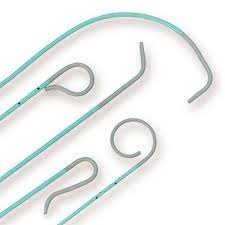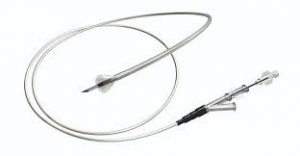
How do doctors use angiography catheter in treatment?
30 January 21
What is an angiography catheter?
Angiography is an X-ray of the vascular system that involves the introduction of contrast into the blood. Moreover, the study of angiography catheter makes it possible to assess the functionality of the vessels, clarify their location and measure the blood circulation rate.
Angiography is an effective method for identifying affected areas, pathological vasoconstriction, pathways of roundabout blood flow, as well as detecting vascular networks in neoplasms.
The advantages of angiography
Doctors of angiography catheter are highly able and competent specialists who have extensive experience in performing angiography and interpreting the results.
The study is carried out on one of the most modern angiographic complexes. The X-ray apparatus with a C-shaped stand and a flat detector provides high-precision high-quality images of the vascular bed.
The procedure takes place in a comfortable environment using safe X-ray contrast agents.
Why does angiography?
Angiography is an examination that allows you to get a complete, most reliable picture of the state of the vascular system of the human body. Basically, angiography catheter research is necessary for:
- diagnostics of a wide range of diseases of the cardiovascular, urinary, musculoskeletal systems and neurological diseases;
- preoperative preparation (in some cases);
- constant X-ray control during endovascular and other operations;
- a controlled study to evaluate the effectiveness of vascular surgery.
Indications for angiography catheter
Doctors recommend angiography catheter in the presence of symptoms of the following abnormalities:
- atherosclerosis of the coronary arteries, ischemic heart disease;
- pulmonary embolism;
- aneurysms (dilation) of arteries and veins;
- atherosclerosis and vascular thrombosis of the lower and upper extremities;
- ischemic stroke;
- defects of the atrial and interventricular septum of the heart.
In addition, physicians perform angiography to diagnose various neoplasms of internal organs (tumor processes, cysts, etc.), assess the condition of the kidneys, and so on.
Contraindications and restrictions
Contraindications to angiography may be:
- serious mental disorders;
- allergic reaction to contrast;
- lack of access to blood vessels;
- acute inflammatory and infectious processes;
- severe blood clotting disorders;
- decompensated hepatic and renal failure.
Preparing for angiography
Hence, for all patients who are planning to undergo angiography?
- blood tests (UAC, OAM, blood biochemistry, blood group, and Rh factor);
- Consultations with specialists (cardiologist, vascular surgeon, neurologist, gastroenterologist, endocrinologist, and other doctors if necessary).
It is also necessary to tell doctor about the existing chronic diseases, medications, and allergies (if any). You should stop drinking alcoholic beverages 14 days before the study. Further, compliance with these recommendations will allow you to get reliable results.
How is angiography performed?
Angiography catheter takes 20-30 minutes and it completes, as a rule, on an outpatient basis. In difficult cases, it is possible to place the patient in a hospital (from 1 to 10 days). Moreover, the procedure takes place in several stages:
- The introduction of a sedative and antiallergic agent.
- Disinfection and local anesthesia of the study site.
- Introduce an introducer (small, short tube) into the artery.
- Placement of a catheter into a vessel through an introducer and introduction of contrast.
- X-ray shooting of the necessary area of the vascular system in several projections using an angiography.
- Removing the catheter and introducer from the vessel, applying a tight bandage to the puncture site.
Moreover, after angiography, our expert physicians advise patients to remain at rest for 6 to 10 hours. In fact, bed rest will prevent thrombosis.
Types of angiography
Doctors network of medical clinics perform the following types of angiography:
- coronary angiography – examination of the heart vessels;
- peripheral angiography – assessment of the state of peripheral vessels.
In addition, the doctors can conduct angiography of vessels of other organs, if necessary.
Survey results
The results of angiography catheter directly depend on which area was examined. Therefore, the concept of the norm, in this case, may differ, but in all cases, the vessels should have even contours, their lumen should decrease evenly and look like branching.
If physicians find pathologies during the study, our specialists in the diagnosis of vascular diseases will advise you and prescribe additional examinations.
Moreover, you can make an appointment with the specialist doctors, who will select the most effective treatment.
Angiography appointment
The catheter facilitates access to the patient’s veins, making visits to the hospital less unpleasant, especially in cancer treatment
Basically, you can find angiography catheter in various forms and at different times. He will be present throughout the chemotherapy, being a great companion to the patient. However, it is necessary to pay attention to some precautions so that this partner does not become a danger.
Fast thing!
If the person needs to spend a short time with the inserting catheter, he can choose a short stay, which is partially inside the skin. Clinicians usually place it in the peripheral veins in the upper limbs, such as arms and hands, and can be rigid or flexible. They are usually helpful to use in emergency rooms since the idea is to be faster.
Not so fast!
Angiography catheter, arm access, central venous access, types of chemotherapy catheter, types of catheter, what is a catheter
This type of catheter is useful when it is necessary to have access for a longer time. It is also partially inside the skin, but physicians can place it in the peripheral veins.
Why do doctors use angiography catheter?
Here, there is a need for the medical team to have access to the patient’s vein for longer. They can partially implant a catheter or fully implanted. Both are tunneled and they can insert in the thoracic region, to make it safer and less uncomfortable for the patient.
What types of the catheter for chemotherapy?
All angiography catheters are useful to indicate for chemotherapy as long as there are vascular conditions of the patient for such treatment”.
To know which one to use, the qualified professional will evaluate the clinical, physical conditions and the treatment protocol. The amounts of drugs to be administered simultaneously also influence this analysis.
Another very important type of chemotherapy that will be part of the treatment: whether they are vesicants or irritants.
What are the side effects of using catheter?
If vesicant drugs are used, it is preferable to use the catheter with central venous access. This is because, if this type of medicine leaks, it can cause irritation and blisters on the skin. So, due to the way that the central access is inserted, it makes it more secure than the peripheral.
“The irritants can be administered by any type of catheter. Thus, if they come into contact with the skin, they produce temporary and less aggressive effects”.
Conclusion
The catheter is one of the most common use equipment in nursing and medicine. Anyone who has been to a hospital has certainly had contact with this thin, flexible tube! Its main function is to facilitate access to the patient’s vein to administer medication, or even collect samples for exams.
Depending on the treatment that will be done, and the patient, the best type of angiography catheter is chosen. There are several, so there will be plenty of options!


